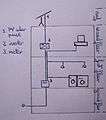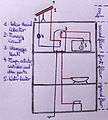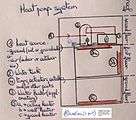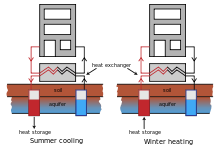Off-the-grid
Off-the-grid or off-grid is a characteristic of buildings and a lifestyle[1] designed in an independent manner without reliance on one or more public utilities. The term "off-the-grid" traditionally refers to not being connected to the electrical grid, but can also include other utilities like water, gas, and sewer systems, and can scale from residential homes to small communities. Off-the-grid living allows for buildings and people to be self-sufficient, which is advantageous in isolated locations where normal utilities cannot reach and is attractive to those who want to reduce environmental impact and cost of living. Generally, an off-grid building must be able to supply energy and potable water for itself, as well as manage food, waste and wastewater.
Energy solutions

Energy for electrical power and heating can be generated on-site with renewable energy sources such as solar (particularly with photovoltaics), wind, or micro hydro. Additional forms of energy include biomass, commonly in the form of wood, waste, and alcohol fuels and geothermal energy, which uses differences in the underground temperature to regular indoor air environments in buildings.[2] It is possible to simply eliminate electric power such as in Old Order Amish and Old Order Mennonite communities.
Electrical power
Grid-connected buildings receive electricity from power plants, which mainly use natural resources such as coal and natural gas as energy to convert into electrical power. 2017’s breakdown of world energy sources[3] shows that the globe, mainly dependent on grid power, uses a majority of non-renewables, while popular renewables such as solar PV and wind power are a small portion. When off the grid, such as in Africa where 55% people of do not have access to electricity,[4] buildings and homes must take advantage of the renewable energy sources around them, because it is the most abundant and allows for self-sufficiency.
Solar photovoltaics
Solar photovoltaics (PV), which use energy from the sun, are one of the most popular energy solutions for off-grid buildings. PV arrays (solar panels) allow for energy from the sun to be converted into electrical energy. PV is dependent upon solar radiation and ambient temperature. Other components needed in a PV system include charge controllers, inverters, and rapid shutdown controls.[5]
Wind turbines
Another popular source for off-grid power is wind energy, harnessed by wind turbines. Wind turbines components consist of blades that get pushed by wind, gearboxes, controllers, generators, breaks, and a tower.[6] The amount of mechanical power captured from a wind turbine is a factor of the wind speed, air density, blade rotational area, and the aerodynamic power coefficient of the turbine.[7]
Micro-hydro
Where water is abundant, hydropower is a promising energy solution. Large scale hydropower involves a dam and reservoir and small scale micro-hydro can use turbines in rivers with constant levels of water. Micro-hydro has potential to power homes and small communities, making a great off-grid choice. The amount of mechanical power generated is a factor of the flow of the stream, turbine size, water density, and power coefficient, similar to wind turbines. The energy from waves and tides can also be provide power to coastal areas.[8]
Batteries
When renewables produce energy that is not currently needed, the electrical energy is usually directed to charge a battery. This solves intermittency issues caused by the non-constant production of renewables and allows for variations in building loads. Common batteries include the lead-acid battery and lithium-ion battery.[9]
Hybrid energy systems
In order to protect against intermittency issues and system failures, many off-grid communities create hybrid energy systems. These combine traditional renewables like solar PV, and wind, with more constant sources of power like micro-hydro or even diesel generators. Tfective than extending grids to isolated communities.
Water and sanitation
Water is a crucial consideration in the off-grid environment, which must be collected, used, and disposed of efficiently to make use of the environment. There are many ways to supply water for indoor domestic use, which vary based on local access and preference.
Sources
Local water bodies
Nearby streams, ponds, rivers, and lakes are easy access points for fresh water. Oceans can also be considered with proper desalination.
Wells and springs
This traditional method involves digging down to where water is present and abundant underground, usually to the water table or to an aquifer, and bringing it up for use, or collecting at springs where underground water comes to the surface.[10] Systems for bringing underground water to buildings include wind and solar driven pumps or hand pumps.[11] Well water should be tested on a regular basis and when changes in the water’s taste, odor, or appearance occur to ensure its quality.[12]
Rain catchments
This system relies on the weather to provide water. Catchment systems are designed based on the water demand of the users and local rainfall characteristics.[13] Rain water is typically funneled from the roof of a building to water tanks where the water is stored until needed.
Foreign supplies
Another, less self-sufficient method involves bringing large amounts of clean water to the site where it is stored. This system relies on access to clean drinking water elsewhere and transportation to the off-grid site.[14]
Treatment
Wherever the water does come from, it must be safe to drink and use indoors. For various issues with water quality, different water treatment strategies are available.
Filtration
A physical barrier allows water to pass through and blocks impurities in the water and, if the filter is fine enough, can filter out biological contaminants.[15]
Chemical treatment
In order to disinfect water, such as chlorine, chlorine dioxide, and ozone are introduced which kill microorganisms.[16]
Ultraviolet light (UV)
A UV system uses bulbs that emit ultraviolet light into filtered water to kill all types of viruses, bacteria, and protozoa.[17]
Electrochemically activated solutions
A less typical approach, this involves applying a current to water that has a small salt solution added to disinfect biological contaminants.[18] Combined with filtration, this is a means to provide safe drinking water.
Desalination
Some groundwater may have high salinity levels[19] and can be non-potable, which is fixed through distillation. Coastal communities may benefit by getting water from the ocean through the use of desalination plants that remove salt.
Water softening
The presence of certain minerals in water creates hard water which can clogs pipes over time, interfere with soap and detergents, and can leave scum on glasses and dishes. Water softening systems introduce sodium and potassium ions which make the hard minerals precipitate.[20]
Usage and sanitation
For off-grid buildings, efficient use of water is needed to prevent water supplies from running out. While this is ultimately habit-dependent, measures involve low-flow fixtures for faucets, shower heads, and toilets which decreases the flow rate of faucets or the volume of water per flush to reduce total water used. Water can be eliminated in toilets through the uses of a composting toilet.[21] Automatic leak detectors and tap closures can reduce amounts of wasted water. Greywater recycling can further save on water by reusing water from faucets, showers, dishwashers, and clothes washers. This is done through storing and treating the greywater, which can then be reused as a non-potable water source.
If an off-grid home is not connected to a sewer system, a wastewater system must also be included. On-site wastewater management is usually done through storage and leaching. This involves storing greywater and blackwater in a septic tank or aeration tank to be treated, which is connected to a leaching field that slowly allows the water to percolate out into the ground. While more and expensive waste water treatment options are also available, this is a common reliable means to dispose of waste water without polluting the environment,
Environmental impact and sustainability
Because off-grid buildings and communities mainly rely on upon renewable energy, off-grid living is generally good for the environment with little negative impact. Hybrid energy systems also provide communities with a sustainable way to live without the dependence and cost of being connected to public infrastructure which can be unreliable in developing countries. Generally, isolated concerns of environmental impacts are the use diesel generators, which produce greenhouse gases, batteries, which use many resources to make and can be hazardous, and pollution in natural environments from solid waste and wastewater. It is prudent to note that, while the concerns below address negative environmental impacts, going off-grid as a whole is a viable option to help reduce impacts on the environment when replacing grid-connected buildings that contribute global warming and climate change.
Diesel generator concerns in Canadian off-grid communities
Canada has about 175 aboriginal and northern off-grid communities, defined as "a community that is neither connected to the North American electrical grid nor to the piped natural gas network; it is permanent or long-term (5 years or more), and the settlements have at least 10 permanent buildings."[22] Aboriginal Affairs and Northern Development Canada lists the following environmental concerns for these off-grid communities:
- Burning large amounts of diesel produces substantial greenhouse gas emissions. This contributes to climate change which negatively affects communities.
- Fuel must be transported long distances by airplane, truck or barge, leading to a greater risk of fuel spills.
- The transportation of fuel by trucks on winter roads impacts the environment negatively through high greenhouse gas emissions from the vehicles.
- Fuel spills may take place while the fuel is being transported and stored, posing environmental risks.
- Fuel tank leaks contaminate soil and groundwater.
- Generators can be noisy and disruptive, especially in quiet, remote communities.
- Emissions from diesel generators could contribute to health problems in community members.[22]
The environmental impacts of the systems used in off-grid buildings must also be considered due to embodied energy, embodied carbon, choice and source of materials, which can contribute to world issues such as climate change, air, water, and soil pollution, resource depletion and more.[23]
Life-cycle assessment of off-grid electric systems
- The lowest impacts of a hybrid micro-grid system are with a solar PV, wind turbine, and lead-acid battery
- Highest impacts are associated a wind turbine, diesel generator, lead-acid battery system
- Hybridization is found to reduce environmental impacts by 40% for off-grid electricity
- Batteries are a big contributor to mineral resource depletion
- Solar PV has lower global climate change effects than wind turbines, but wind turbines have a lower land area use.
Sustainable communities
The concept of a sustainable off-grid community must take into consideration the basic needs of all who live in the community. To become truly self-sufficient, the community would need to provide all of its own electrical power, food, shelter and water. Using renewable energy, an on-site water source, sustainable agriculture and vertical farming techniques is paramount in taking a community off the grid. A recent concept design by Eric Wichman shows a multi-family community, which combines all of these technologies into one self-sufficient neighborhood. To grow the community you simply add neighborhoods using the same model as the first. A self-sustained community reduces its impact on the environment by controlling its waste and carbon footprint.
Economic consideration
In situations where grid parity has been reached, it becomes cheaper to generate one's own electricity rather than purchasing it from the grid. This depends on equipment costs, the availability of renewable energy sources, and the cost of a grid connection. For example, in certain remote areas a grid connection would be prohibitively expensive, resulting in grid parity being reached immediately.
It is often done to residential buildings only occasionally occupied, such as vacation cabins, to avoid high initial costs of traditional utility connections. Other people choose to live in houses where the cost of outside utilities is prohibitive, or such a distance away as to be impractical. In his book How to live off-grid Nick Rosen lists seven reasons for going off-grid. The top two are saving money, and reducing the carbon footprint. Others include survivalists, preparing for the collapse of the oil economy and bringing life back to the countryside.[24]
Off-grid power for marginalized communities
Reliable centralized electricity systems have provided supply constancy which has bolstered societies and their economies.[25] Electricity provides opportunities for improved productivity, learning, and hygienic end-uses in the home, such as cooking without the use of polluting biomass fuel sources, yet as of 2016, 20 percent of people world wide lived without it.[26] Bridging the gap from the current under-provision of grid electricity to universal access has been projected to require US$17 trillion and 30 years even on a rigorous timetable.[27] Researchers have argued that a lack of centralized energy infrastructure can result in low resilience to damage to productivity and property from changing climates and severe weather.[27][28] In addition, the advantages of central power generation and distribution are receding in the face of climatic degradation due to fossil fuel powered generation, vulnerabilities to extreme weather events and electronic manipulation, and increasingly complex design and regulatory processes.[25]
Decentralized, off-grid energy systems can constitute a sustainable interim alternative to extending national grids to rural customers.[28] Those using limited off-grid power as a stepping stool to eventual grid access can accumulate energy efficient knowledge, behavior, and products that confer added resiliency while grid networks increase in reliability[28] and carbon neutrality. However, providing off-grid electricity to rural users without also including training and education about its use and applications can result in under-utilization.[27][29] To counteract this possibility, off-grid systems should reflect the cultural structures, values, and mores of host communities.[26][30]
Off-grid electrical systems can power individual residences or a community linked in a shared arrangement known as a micro-grid. In addition, they may be powered by renewable energy sources or by conventional fossil fuels. In Kenya, Mpeketoni township began a community-based, diesel-powered micro-grid project (the Mpeketoni Electricity Project [MEP]) in 1994 with an outlay of approximately US$40,000, and eventually grew to serve 105 residences and 116 commercial, educational, government, and healthcare buildings.[31] The MEP demonstrated unanticipated supply and demand effects when artisans using tools powered by MEP electricity increased their productivity enough to cause depreciation of their wares, necessitating lowering of their prices; however, higher volumes of sales eventually offset these losses.[31] MEP electricity facilitated cold storage of agricultural products, in addition to well pumping, which allowed students who previously spent several hours per day fetching water to spend that time studying in the evening by electric light.[31] Electricity provided by the MEP also expanded teaching hours and sanitation at local schools through electric lighting and pumped water.[31] The MEP off-grid project had numerous direct and indirect benefits for community members, and because the MEP emphasized promotion of the uses for electricity and the community had the ability to pay nominal rates for its use, the project achieved 94 percent cost recovery in its first ten years of operation.[31]
Popular culture
A wave of TV shows and articles came out after the publication of "Off the Grid, Inside the Movement for More Space, Less Government and True Independence in Modern America" by Nick Rosen in 2010.[24]
The idea has been recently popularized by certain celebrities including Ed Begley, Jr.[32] who stars in the Living with Ed[33] television show on the Home & Garden Television (HGTV) network. Actress Daryl Hannah promotes off-grid living and constructed her home in Colorado according to those principles, as does survival expert and Dual Survival co-star Cody Lundin,[34] who lives in a self-designed, passive solar earth house in the high-desert wilderness of Northern Arizona, collecting rainwater, composting waste, and paying nothing for utilities.[35][36]
See also
- Anarcho-primitivism
- Autonomous building
- Back-to-the-land movement
- Battery charger
- Distributed generation
- Domestic energy consumption
- Inverter
- Microgeneration
- Rural electrification
- Simple living
- Slab City, California
- Solar charge controller
- Solar Guerrilla
- Sungevity
- Wide area synchronous grid
- Zero energy building
Gallery
 Incomplete DIY Wind generator system
Incomplete DIY Wind generator system A PV-solar system
A PV-solar system Schematic of an active solar heating system
Schematic of an active solar heating system A HVAC heat pump system
A HVAC heat pump system Treatment ponds can be used for purifying water
Treatment ponds can be used for purifying water Heat and cold storage may be combined with heat pumps for use in the domestic greenhouse or to heat the house itself
Heat and cold storage may be combined with heat pumps for use in the domestic greenhouse or to heat the house itself
References
- Vannini, Phillip; Taggart, Jonathan (2014). Off the Grid: Re-Assembling Domestic Life. Routledge. p. 10. ISBN 978-0415854337.
- Andrew (2012-11-05). "Geothermal Heat Pumps: Letting The Earth Provide". Off The Grid News. Retrieved 2019-12-09.
- Aziz, Ali Saleh; Tajuddin, Mohammad Faridun Naim; Adzman, Mohd Rafi; Azmi, Azralmukmin; Ramli, Makbul A. M. (2019-08-01). "Optimization and sensitivity analysis of standalone hybrid energy systems for rural electrification: A case study of Iraq". Renewable Energy. 138: 775–792. doi:10.1016/j.renene.2019.02.004. ISSN 0960-1481.
- Odou, Oluwarotimi Delano Thierry; Bhandari, Ramchandra; Adamou, Rabani (2020-01-01). "Hybrid off-grid renewable power system for sustainable rural electrification in Benin". Renewable Energy. 145: 1266–1279. doi:10.1016/j.renene.2019.06.032. ISSN 0960-1481.
- Burdick, Joe; Schmidt, Philip. "Go Off-Grid with Solar Power - Renewable Energy". Mother Earth News. Retrieved 2019-12-09.
- "The Inside of a Wind Turbine". Energy.gov. Retrieved 2019-12-09.
- Gan, Leong Kit; Echenique Subiabre, Estanislao Juan Pablo (June 2019). "A realistic laboratory development of an isolated wind-battery system". Renewable Energy. 136: 645–656. doi:10.1016/j.renene.2019.01.024. ISSN 0960-1481.
- Ramudu, Eshwan (October 2011). "Ocean Wave Energy-Driven Desalination Systems for Off-grid Coastal Communities in Developing Countries". 2011 IEEE Global Humanitarian Technology Conference. IEEE: 287–289. doi:10.1109/ghtc.2011.38. ISBN 978-1-61284-634-7.
- Scheckel, Paul. "Off-Grid Battery Options". Mother Earth News. Retrieved 2019-12-09.
- Vivian, John. "Off-Grid Water Systems - Nature and Environment". Mother Earth News. Retrieved 2019-12-09.
- "Off-Grid Water Systems: 8 Viable Solutions to Bring Water to Your Homestead". MorningChores. 2016-10-10. Retrieved 2019-12-09.
- "How Safe Is Your Well Water? - LHSFNA". www.lhsfna.org. Retrieved 2019-12-09.
- Ren, Zhengen; Paevere, Phillip; Chen, Dong (May 2019). "Feasibility of off-grid housing under current and future climates". Applied Energy. 241: 196–211. doi:10.1016/j.apenergy.2019.03.068. ISSN 0306-2619.
- "off grid box brings clean water and power to all". designboom | architecture & design magazine. 2017-08-30. Retrieved 2019-12-09.
- "Best Ways to Purify Water When Camping". thesmartsurvivalist.com. Retrieved 2020-03-18.
- "Water Treatment | Public Water Systems | Drinking Water | Healthy Water | CDC". www.cdc.gov. 2018-10-10. Retrieved 2019-12-09.
- "Ultraviolet disinfection of drinking water". ww2.health.wa.gov.au. Retrieved 2019-12-09.
- Clayton, Gillian E.; Thorn, Robin M.S.; Reynolds, Darren M. (August 2019). "Development of a novel off-grid drinking water production system integrating electrochemically activated solutions and ultrafiltration membranes" (PDF). Journal of Water Process Engineering. 30: 100480. doi:10.1016/j.jwpe.2017.08.018. ISSN 2214-7144.
- "Cleaning water without the grid". Main. Retrieved 2019-12-09.
- "Hardness in Drinking Water" (PDF). World Health Organization. 2011.
- "All About Off Grid Wastewater: Options, Septic, Code, and Advice". Accidental Hippies. 2017-07-25. Retrieved 2019-12-09.
- "Off-Grid Communities". Aboriginal Affairs and Northern Development Canada. 2012-05-01. Retrieved 2012-11-08.
- Aberilla, Jhud Mikhail; Gallego-Schmid, Alejandro; Stamford, Laurence; Azapagic, Adisa (January 2020). "Design and environmental sustainability assessment of small-scale off-grid energy systems for remote rural communities". Applied Energy. 258: 114004. doi:10.1016/j.apenergy.2019.114004. ISSN 0306-2619.
- Rosen, Nick (2010). Off the Grid: Inside the Movement for More Space, Less Government, and True Independence. Penguin. ISBN 978-0143117384.
- Bouffard, François; Kirschen, Daniel S. (2008). "Centralised and distributed electricity systems". Energy Policy. 36 (12): 4504–4508. doi:10.1016/j.enpol.2008.09.060.
- Campbell, Ben; Cloke, Jon; Brown, Ed (2016). "Communities of energy: Communities of energy". Economic Anthropology. 3 (1): 133–144. doi:10.1002/sea2.12050.
- Guruswamy, Lakshman (2015-08-20). International Energy and Poverty. doi:10.4324/9781315762203. ISBN 9781315762203.
- Alstone, Peter; Gershenson, Dimitry; Kammen, Daniel M. (2015). "Decentralized energy systems for clean electricity access". Nature Climate Change. 5 (4): 305–314. Bibcode:2015NatCC...5..305A. doi:10.1038/nclimate2512. ISSN 1758-678X.
- Feron, Sarah (2016-12-19). "Sustainability of Off-Grid Photovoltaic Systems for Rural Electrification in Developing Countries: A Review". Sustainability. 8 (12): 1326. doi:10.3390/su8121326. ISSN 2071-1050.
- Sovacool, Benjamin K.; D’Agostino, Anthony L.; Jain Bambawale, Malavika (2011). "The socio-technical barriers to Solar Home Systems (SHS) in Papua New Guinea: " Choosing pigs, prostitutes, and poker chips over panels "". Energy Policy. 39 (3): 1532–1542. doi:10.1016/j.enpol.2010.12.027.
- Kirubi, Charles; Jacobson, Arne; Kammen, Daniel M.; Mills, Andrew (2009). "Community-Based Electric Micro-Grids Can Contribute to Rural Development: Evidence from Kenya". World Development. 37 (7): 1208–1221. doi:10.1016/j.worlddev.2008.11.005.
- "The Renewable Planet | Environmentally friendly living". www.therenewableplanet.com.
- "Living With ED". Living With ED.
- "Living Off the Grid: Free Yourself - DARYL HANNAH ON BEING OFF-GRID". Living Off the Grid: Free Yourself. March 4, 2005.
- Stanley, John (November 1, 2007). "Survival guide aimed at complacent urbanites". The Arizona Republic. Retrieved 2012-08-07.
- Lundin, Cody. "About Cody Lundin". Retrieved 2012-08-07.
External links
- Smithsonian magazine interview about living off-grid
- West Texas Weekly article on John Wells' life off the grid
- Into the wild: the rebels living off-grid all over Europe – in pictures. "They’ve opted out of cities and started all-new rural lives, building their own straw homes, teepees and bath tubs. Since 2010, photographer Antoine Bruy has travelled from the Pyrenees to Romania tracking down urban refuseniks." The Guardian